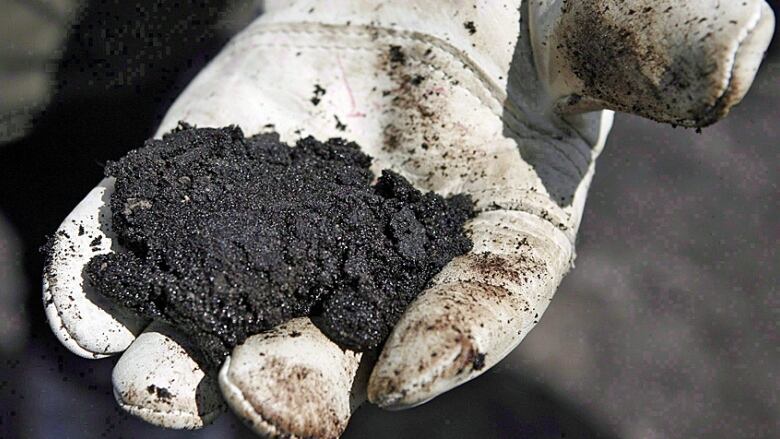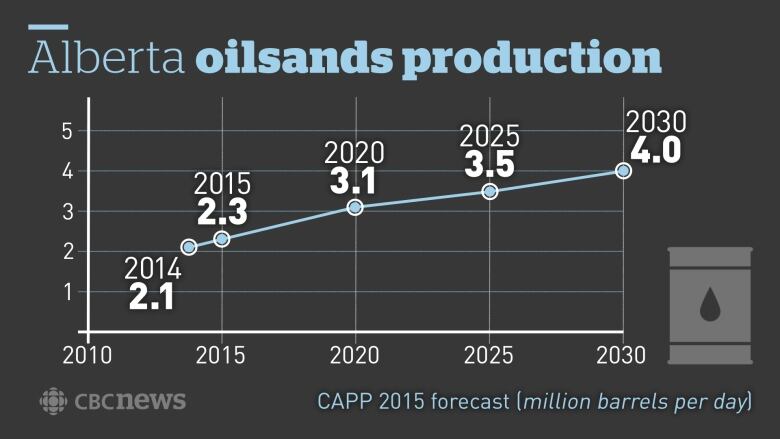Oilsands growth in doubt and could affect national GDP, federal finance report warns
Post-2020 investment to expand Alberta's oilsands could slow or stall

Increased competition, low prices and climate change policy have put the future growth of Alberta's oilsands in doubt and that has the federal government concerned.
Several new projects are under construction in Northern Alberta that will be completed in the next several years and increase oil production. However, after 2020, there is uncertainty about new investment.
- Terra Energy shuts down after bank calls in loan
- Arlene Dickinson:Alberta's recession. Enough talk. Time for us all to take action.
A report by the federal Department of Finance, obtained by CBC News, suggests further oilsands expansion is vulnerable and that could impact the national GDP.
'The report confirmed my main concern, which is long term, theoilsandsare not viable'- Allan Dwyer, Mount Royal University
"The thing that really stuck out for me is that none of the pathways that they describe really define a future where you are really going to see a lot of additional development in the oilsands sector," said Prof. Warren Mabee,an energy researcher at Queens University.
The Liberal government may, in Tuesday's budget, begin to introduce policy to help diversify the economy away from oil, Mabee suggests.
"What we are talking about is a continued transformation," said Mabee, who is director of theQueen's Institute for Energy and Environmental Policy (QIEEP)."We are going to need other parts of the economy to really start picking up the slack."
- Albertaneeds 'iron fist' to enforce oilsands royalty rules
- Jobless oilsands workers look to alternative energy
Post-2020

"We had 17 cancellations or delays in 2015 [of oilsands projects]," said Jackie Forrest, a vice-president with ARC Financial in Calgary. "It's uncertain, even if oil prices come back, how many of those will come back on the books."
Oilsands projects are expensive and take several years of construction before they begin to produce oil, which is why companies may choose to invest in U.S. tight oil plays instead, since those projects are smaller, produce faster and have lower risk, according to Forrest.
- Excessive steaming a factor in CNRL's Primrose leaks
- Shell offshore team loses Styrofoam pipe floats at sea
Tight oil, found in places like North Dakota's Bakkenformation,is typically a hard-to-reachdeposit but has become relatively easy to extractin the past decade with hydraulic fracturing technology.
"There's still going to be investment, but there won't be the wave of investment that we saw in the last five years," she said.
This month, Imperial Oil announced a proposal for a new $2-billion project that could begin producing oil in 2022, although an actual investment decision has yet to be made.
Even if new projects dry up after 2020, Forrest estimates companies will still have to spend around $13 billion annually to maintain current operations.
Economics tough for oilsands
Industry estimates had pegged 2015 oilsandscapital investment atabout $23 billion, compared to $33 billion in 2014.
Oil prices are hovering around $40 US a barrel and, based on different forecasting scenarios by the International Energy Agency, prices could average between $55 and $80 in 2020, andbetween$70 and $113 by 2030.
Currently, oilsands projects generally require oil prices of at least $60 to make money, althoughthe facilities do have a long lifespan to recover capital investment and turn a profit.
"As the marginal supplier of world oil, because of its high costs and climate change footprint, Canadian oilsands would face the brunt of the post-2020 reduction in oil demand (despite the price approaching $80)," said the federal finance report obtained by CBC Newsthrough an access to information request.
'Miss the boat'
"The report confirmed my main concern which is, long term, the oilsands are not viable," said Allan Dwyer, a finance professor at Mount Royal University in Calgary.
"We're going to miss the boat. We're racing as fast as we can, hoping therewill be technological advances which make it cheaper for us to produce oilsands oil," he said. "I don't think we can do it. There hasn't been enough R andD[research and development]."
The report, dated December 9, 2015,lays out what that could mean for the country's economy:
"Production growth will begin to decline in the absence of new investment, and hence the GDP impact from no investment in the oilsands would grow. Such a loss would have to be balanced, however, against that investment moving to other parts of the economy that have traditionally showed higher productivity growth, as well as the impacts of a lower dollar on non-energy manufacturers and exporters. Overall, if oil prices were to remain flat through 2020, rather than rising as projected in the 2015 Budget and recent Fall Update, lower GDP inflation would likely remain the dominant channel of impact."
Besides prices and competition from U.S. tight oil, the oilsandsfaces other headwinds such as climate change policy at the provincial and federal level. What type of carbon pricing and emission regulations will be in place by 2020 is tough to predict, let alone how they will evolve during the lifespan of an oilsands operation. The federal finance report suggests the global trend of climatechange policies "will impact Canada's terms of trade adversely in the long run."













_(720p).jpg)


 OFFICIAL HD MUSIC VIDEO.jpg)
.jpg)



























































































